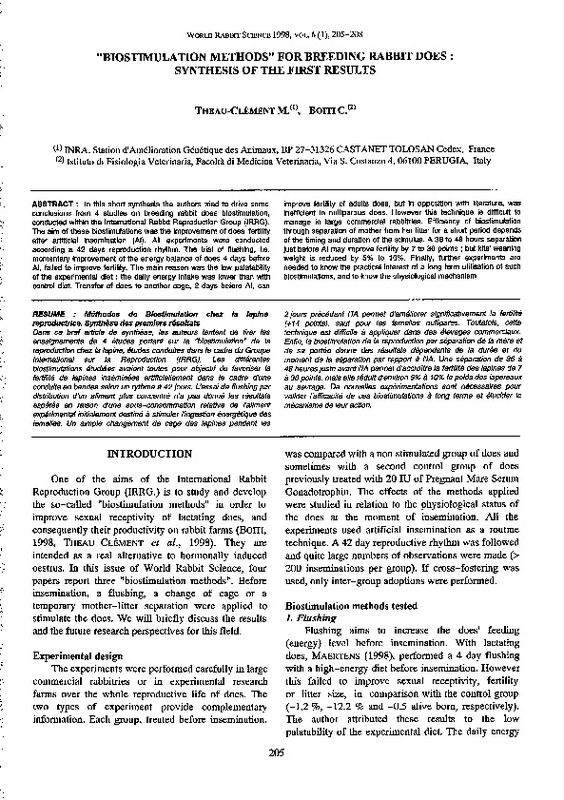JavaScript is disabled for your browser. Some features of this site may not work without it.
Buscar en RiuNet
Listar
Mi cuenta
Estadísticas
Ayuda RiuNet
Admin. UPV
"BIOSTIMULATION METHODS" FOR BREEDING RABBIT DOES: SYNTHESIS OF THE FIRST RESULTS
Mostrar el registro sencillo del ítem
Ficheros en el ítem
| dc.contributor.author | Theau- Clément, M.
|
|
| dc.contributor.author | Boiti, C.
|
|
| dc.date.accessioned | 2011-03-16T11:39:33Z | |
| dc.date.available | 2011-03-16T11:39:33Z | |
| dc.date.issued | 1998 | |
| dc.identifier.issn | 1257-5011 | |
| dc.identifier.uri | http://hdl.handle.net/10251/10392 | |
| dc.description.abstract | [EN] In this short synthesis the authors triad to drive sorne conclusions from 4 studies on breeding rabbit does biostimulation, conducted within the lnternational Rabbit Reproduction Group (IRRG). The aim of these biostimulations was the improvement of does' fertility after artificial insemination (Al). Ali experiments were conducted according a 42 days reproduction rhythm. The trial of flushing, i.e. momentary improvement of the energy balance of does 4 days before Al, failed to improve fertility. The main reason was the low palatability of the experimental diet : the daily energy intake was lower than with control diet. Transfer of does to another caga, 2 days befare Al, can improve fertility of adults does, but in opposition with literatura, was inefficient in nulliparous does. However this technique is difficult to manage in larga commercial rabbitries. Efficiency of biostimulation through separation of mother from her litter for a short period depends of the timing and duration of the stimulus. A 36 to 48 hours separatlon just befare Al may improve fertility by 7 to 30 points ; but kits' weaning weight is reduced by 5% to 10%. Finally, further experiments are needed to know the practica! interest of a long term utilisation of such biostimulations, and to know the physiological mechanism. | es_ES |
| dc.description.abstract | [FR] Dans ce bref artícle de synthiJse, les auteurs tentent de tirar les enseígnements de 4 études portant sur la "bíostimulatíon" de la reproduction chez la lapine, études conduites dans le cadre du Groupe lntemational sur la Reproduction (IRRG). Les différentes biostímulatlons étudiées avaient toutes pour objectif de favoriser la fertílité de tapines inséminées artificiellement dans le cadre d'une conduite en bandas selon un rythme a 42 jours. L'essai de f/ushing par distributlon d'un aliment plus concentré n'a pas donné les résultats espérés en raison d'une sous-consommation relativa de /'aliment expérimental initialement destiné a stimuler l'ingestion énergétique des femelles. Un simple changement de caga des tapines pendant les 2 jours précédant /'/A permet d'améliorer significativement la fertílité (+14 points), sauf pour les femelles nullipares. Toutefois, cette technique est difficile a app/iquer dans des élevages commerciaux. Enfin, la biostimulation de la reproduction par séparation de la mere et de sa portée donne des résu/tats dépendants de la durée et du moment de la séparation par rapport a l'IA. Une séparation de 36 a 48 heures juste avant l'IA permet d'accroitre la fertílité des tapines de 7 a 30 points, mais elle réduit d'environ 5% a 10% le poids des lapereaux au sevrage. De nouvelles expérimentations sont nécessaires pour validar /'efficacité de ces biostimulations a long terma et é/ucider le mécanisme de leur action. | |
| dc.language | Inglés | es_ES |
| dc.publisher | World Rabbit Science. ICTA. UPV | es_ES |
| dc.relation.ispartof | World Rabbit Science | |
| dc.rights | Reserva de todos los derechos | es_ES |
| dc.title | "BIOSTIMULATION METHODS" FOR BREEDING RABBIT DOES: SYNTHESIS OF THE FIRST RESULTS | es_ES |
| dc.type | Artículo | es_ES |
| dc.date.updated | 2011-03-15T11:51:17Z | |
| dc.identifier.doi | 10.4995/wrs.1998.344 | |
| dc.rights.accessRights | Abierto | es_ES |
| dc.description.bibliographicCitation | Theau- Clément, M.; Boiti, C. (1998). "BIOSTIMULATION METHODS" FOR BREEDING RABBIT DOES: SYNTHESIS OF THE FIRST RESULTS. World Rabbit Science. 06(1). https://doi.org/10.4995/wrs.1998.344 | es_ES |
| dc.description.accrualMethod | SWORD | es_ES |
| dc.relation.publisherversion | https://doi.org/10.4995/wrs.1998.344 | |
| dc.description.volume | 06 | |
| dc.description.issue | 1 | |
| dc.identifier.eissn | 1989-8886 | es_ES |








